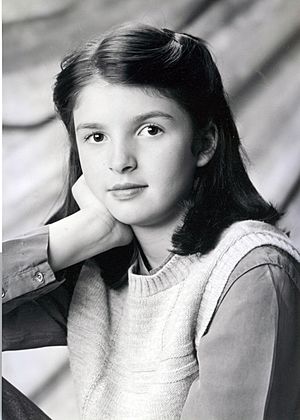Emily Rosa facts for kids
Quick facts for kids
Emily Rosa
|
|
|---|---|

Age 11 in 1998
|
|
| Born | February 6, 1987 |
| Nationality | American |
| Occupation | Psychologist, scientist |
| Parent(s) | Linda Rosa, Larry Sarner |
Emily Rosa (born February 6, 1987) is a remarkable scientist. She became famous for her research paper published in a medical journal when she was only nine years old. This made her the youngest person ever to have a scientific study printed in such an important publication.
Emily's study looked into something called "Therapeutic Touch." This is a practice where people claim they can heal others by moving their hands over the body without actually touching it. Her work was published in the Journal of the American Medical Association in 1998. Emily later went on to study psychology at the University of Colorado at Denver, graduating in 2009.
Contents
Emily's Science Experiment
In 1996, Emily saw a video about Therapeutic Touch (TT). People practicing TT said they could feel a "Human Energy Field" (HEF) around people. They claimed they could use their hands to change this energy field to help diagnose and treat illnesses.
Testing Therapeutic Touch
Emily heard one of the creators of Therapeutic Touch, Dolores Krieger, say that everyone could feel the HEF. Other nurses described the HEF as feeling "warm as Jell-O" or "tactile as taffy." Emily was very impressed by how sure these nurses were about their special abilities. She thought, "I wanted to see if they really could feel something."
For her 4th-grade science fair, Emily designed a simple but clever experiment. She used a standard science fair display board. The experiment had two parts. First, in 1996, she tested 15 TT practitioners in their homes. Then, in 1997, she tested 13 practitioners, including some from the first group. This second part was even filmed by Scientific American Frontiers.
How the Experiment Worked
Emily's study tested if 21 TT practitioners could really feel the HEF without looking. Each practitioner sat at a table. They put their hands through a screen so they couldn't see Emily. On the other side of the screen, Emily randomly chose one of the practitioner's hands. She then held her own hand over it.
The TT practitioners had to guess which of their hands Emily was holding her hand over. Each person got ten tries. However, they only guessed correctly about 4.4 times on average. This is about the same as guessing randomly. Some practitioners even got to choose which of Emily's hands they thought had the strongest HEF before the test. But even then, they didn't do any better.
What Emily Discovered
The results showed that the TT practitioners could not tell which hand Emily was holding hers over any better than pure chance. Because of this, Emily and her co-authors concluded that there was no real scientific proof for the "Human Energy Field." This also meant there was no scientific basis for Therapeutic Touch.
Emily's study was published on April 1, 1998, in the Journal of the American Medical Association (JAMA). The editor of JAMA, George Lundberg, said, "Age doesn't matter. It's good science that matters, and this is good science."
Public Reaction to the Study
When Emily's experiment was published in JAMA, it became a huge news story around the world. Many people talked about it. In an article in The New York Times, Emily was compared to the child in the story "The Emperor's New Clothes." In that tale, a child points out that the emperor is wearing no clothes, even though everyone else pretends he is.
Some people raised questions about how the study was done. They said the TT operators were told it was just a "fourth grade science fair project." However, the first part of the study truly was just for a science fair. The idea to publish it came later. The second part of the study was filmed, and participants knew they were being recorded. No other experiment has shown different results from Emily's findings.
Awards and Recognition
For the Therapeutic Touch Experiment
- 1999: Emily was recognized by the Guinness Book of World Records. She was named the youngest person to have research published in a scientific or medical journal.
Other Achievements
- 2000: She won 1st Place in the Junior Division Earth & Space Sciences at the Colorado Science and Engineering Fair. This was for her project called Geodesy: Measuring the Circumference of the Earth with Original Instruments.
- 2003: Emily received "The Future of Free Thought" Award from the Atheist Alliance International.
Public Appearances
Emily Rosa appeared on many TV shows and news programs. These included ABC, CBS, NBC, PBS, BBC, Fox, CNN, and MSNBC. She was also on Nick News and Scientific American Frontiers multiple times.
In 1998, Emily gave a speech at the Ig Nobel Ceremonies at Harvard University. She accepted an award for Dolores Krieger, who was not there. Krieger was honored for showing the "merits of therapeutic touch." Emily thanked Dr. Krieger for leaving the basic research in TT for her to do. The next day, Emily gave another speech at MIT.
See also
 In Spanish: Emily Rosa para niños
In Spanish: Emily Rosa para niños

